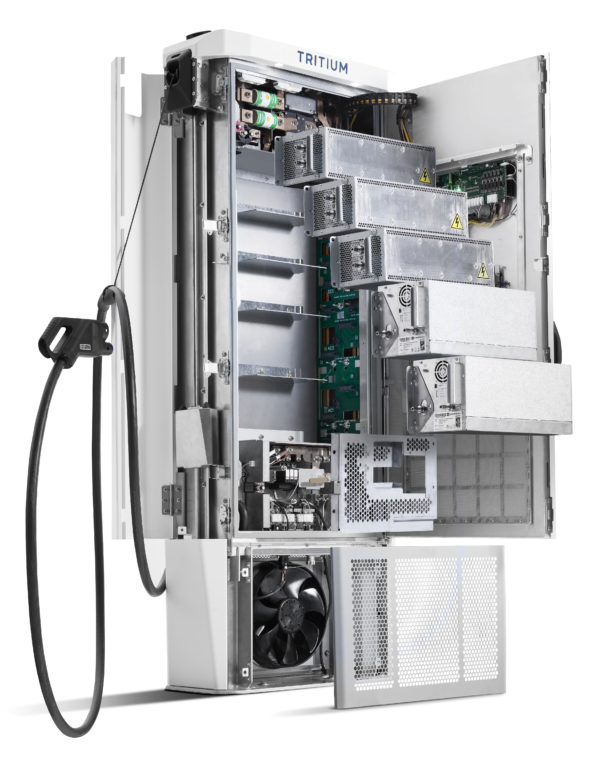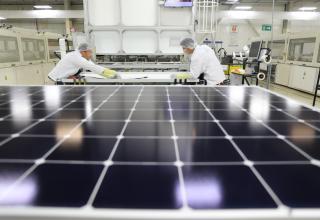https://www.pv-magazine-australia.com/2022/01/14/five-things-every-solar-expert-should-know-about-ev-charging/

Inside Tritium’s new high powered electro-magnetic compliance (EMC) test chamber
Tritium
With residential solar photovoltaic (PV) outpacing commercial and industrial capacity for the first time globally, electric vehicle (EV) sales setting a new monthly record of more than 721,000 and countries like Norway announcing that more than 65% of its citizens now drive electric, it’s clear that the world is electrifying at an unprecedented pace. The sustainability industry is moving beyond innovators to early adopters, this transition presents an amazing opportunity for industry collaboration – to build complete and connected systems focused on improving the lives of the world’s inhabitants.
After spending more than a decade in Australia’s solar industry, and now recently joining Tritium, a global developer and manufacturer of direct current (DC) fast charging technology for EVs, I’ve gained a unique perspective on both the solar and EV charging industries. While PV and EV charging are both revolutionary technologies that are typically grid connected, based on power conversions between DC and alternating current (AC), and power batteries, it’s the differences between the two technologies I’ve found most interesting.

Tritium
Here are the five things I didn’t know about EV charging before I joined Tritium.
1. DC fast charging uses multistage power conversion
Solar inverters are typically transformerless and complete a single power conversion from DC to grid AC. By comparison, Tritium’s DC fast chargers perform three power conversions:
- Grid AC to vehicle battery DC – a process known as rectification
- Constant DC to variable DC – this is to ensure that the power being delivered by the charger matches the variable voltage and current requirements of the vehicle’s battery over the course of the changing session
- Galvanic isolation –a safety requirement to ensure that there’s no continuous electrical path between the grid and the EV
Undertaking three power conversion stages produces heat, so the cooling system of the DC fast charger becomes very important. Tritium has approached this problem by using liquid cooling systems in the company’s IP65 rated charging stations.
2. AC vs DC
EVs today commonly support both AC and DC charging. The AC support allows customers to charge at home using relatively cheap, but slow, AC charging units. That’s because with AC charging the power conversion steps mentioned above must be built into the vehicle, which means that every EV is obliged to allocate space, weight and cost to an onboard charger. Vehicle manufacturers understandably look to keep the space, weight and cost of the onboard charger as low as possible and this has resulted in the supported AC charging rates being relatively slow – usually just 7kW to 11kW.
By comparison, DC fast chargers directly supply the variable DC voltage and current required by the EVs battery while charging. And it’s not just the three power conversion stages that DC fast chargers are taking responsibility for, it’s also the heat rejection from the multiple power conversions. This allows the charging rates to be significantly higher than AC units. For example, Tritium’s range spans from 50kW to 350kW.
3. DC fast charging puts serious power into people’s hands
It’s a testament to the comprehensive nature of international standards that DC fast chargers can enable any EV owner to safely use and manipulate a charging cable that could be carrying voltages up to 920V or current up to 500A. In fact, most EV charging cables that are rated at 400A or higher utilise liquid cooling directly inside the cable to keep the cable manageable and not prohibitively heavy. Tritium uses this approach to delivery continuous 500A output on the company’s 350kW rated chargers.
4. High tech software to manage systems
When it comes managing a solar power system, it’s largely set and forget. Of course it’s recommended to check the system on a regular basis, but we all know that most solar customers only think about their system when the power bill turns up. By comparison, DC fast chargers are often installed in public locations and need to manage payments. And when you start dealing with money, set and forget may not cut it!
EV chargers are at their best when actively managed by a Charge Point Operator (CPO), a company that runs a charging network for public use. CPOs usually manage their network remotely through backend management software, which dispatches commands to the charger via an industry standard called Open Charge Point Protocol (OCPP). This standard allows the CPO to authenticate customers, start and stop charging sessions, apply active load management profiles and track simple parameters like power, voltage and current.
The key system management and charging cable communication standards already support advanced technologies like ISO 15118 Plug and Charge, where the vehicle authenticates directly with the DC fast charger without any further interaction from the driver, which is a great solution for fleets and ride share services. These standards are currently being reviewed and extended further to support future technologies like vehicle-to-grid and other grid support services.
Related to the need for active management via OCPP is the possibility that DC fast chargers may be installed in an unattended location. In fact, this is the great benefit of powering vehicles with electricity – we already have a grid that extends far and wide, so DC fast chargers can be installed just about anywhere with three phase power, and even in some locations that don’t. This is distinctly different to petrol stations, which nearly always have dedicated locations and staff available to assist with the equipment or payment, if required. Tritium chargers can be optioned with an integrated credit card reader to allow for ad-hoc payment without needing to be signed up to a membership program.
5. Deeper system connection and integration is on the horizon
DC fast charging systems so far have been relatively insular – once installed they perform their function without consideration of external factors beyond OCPP commands and payments. Moving forward, I expect to see fast charging to be increasingly integrated with onsite solar and energy storage systems, onsite energy management and demand response systems, and scheduling systems for fleet applications.
Onsite energy storage is of particular interest as many suitable DC fast charging sites have grid constraints that restrict the size or number of charging stations that can be installed without grid augmentation. Another less capital-intensive approach is to “over-subscribe” the onsite rectification to effectively deliver a higher number of kW of DC power delivery than offered by the rectification. Tritium’s recently launched PKM150 system is the first in the market to implement this strategy.
The views and opinions expressed in this article are the author’s own, and do not necessarily reflect those held by pv magazine.
This content is protected by copyright and may not be reused. If you want to cooperate with us and would like to reuse some of our content, please contact: editors@pv-magazine.com.
<



